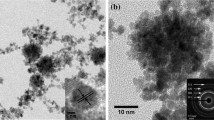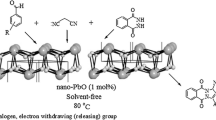Abstract
A number of methods exist for the preparation of platinum nanoparticles, which have numerous industrial applications, especially as catalysts. In this study, we compared three methods for preparing Pt particles with diameters in the range of 1–3 nm. Method 1 involves base-catalyzed reduction of Pt(IV) in ethylene glycol. Methods 2 and 3 are based on phase transfer of a Pt(IV) precursor from water to toluene containing a phase-transfer catalyst (PTC) followed by reduction by NaBH4 and capping by a stabilizing agent. The latter two methods differ in the sequence of addition of stabilizer and reducing agent, and in the nature of the stabilizer. We compared the resulting mean particle sizes using transmission electron microscopy and dynamic light scattering. Our study included a systematic comparison of seven reaction parameters for Methods 2 and 3: the method (sequence of addition), Pt precursor, stabilizer molecule, stabilizer concentration, PTC, PTC concentration, and solvents for Pt suspension. Our data show that, both qualitatively and quantitatively by means of analysis of variance, three of these parameters are significant: method, stabilizer, and PTC. A linear regression allows for prediction of particle size based on these variables and fits the experimental data well, allowing particle size to be adjusted in the range of 1.6–2.2 nm. A gravimetric determination of the yield of the three methods found that while Methods 1 and 2 convert at least 85 % of the Pt precursor to Pt nanoparticles, for Method 3, the yield was less than 30 %.









Similar content being viewed by others
References
Ahmadi TS, Wang ZL, Green TC, Henglein A, El-Sayed MA (1996) Shape-controlled synthesis of colloidal platinum nanoparticles. Science 272:1924
Allen FH, Kennard O, Watson DG, Brammer L, Orpen AG, Taylor R (1987) Tables of bond lengths determined by X-ray and neutron diffraction. Part 1. Bond lengths in organic compounds. J Chem Soc Perk Trans 2 0:S1–S19
Bönnemann H, Richards RM (2001) Nanoscopic metal particles—synthetic methods and potential applications. Eur J Inorg Chem 2001(10):2455–2480
Brust M, Walker M, Bethell D, Schiffrin DJ, Whyman R (1994) Synthesis of thiol-derivatised gold nanoparticles in a two-phase Liquid-Liquid system. J Chem Soc Chem Commun 801–802
Cao M, Miyabayashi K, Shen Z, Ebitani K, Miyake M (2011) Olefin hydrogenation catalysis of platinum nanocrystals with different shapes. J Nanoparticle Res 13:5147
Castro EG, Salvatierra RV, Schreiner WH, Oliveira MM, Zarbin AJG (2010) Dodecanethiol-stabilized platinum nanoparticles obtained by a two-phase method: synthesis, characterization, mechanism of formation, and electrocatalytic properties. Chem Mater 22:360
Chaston JC (1975) The oxidation of the platinum metals. Platinum Met Rev 19:135
Dassenoy F, Philippot K, Ould Ely T, Amiens C, Lecante P, Snoeck E, Mosset A, Casanove MJ, Chaudret B (1998) Platinum nanoparticles stabilized by CO and octanethiol ligands or polymers: FT-IR, NMR, HREM and WAXS studies. New J Chem 22:703
De Rogatis L, Cargnello M, Gombac V, Lorenzut B, Montini T, Fornasiero P (2010) Embedded phases: a way to active and stable catalysts. ChemSusChem 3:24
Ertan S, Şen F, Şen S, Gökağaç G (2012) Platinum nanocatalysts prepared with different surfactants for C1–C3 alcohol oxidations and their surface morphologies by AFM. J Nanoparticle Res 14:1
Guerra J, Burt J, Ferrer D, Mejía S, José-Yacamán M (2011) Influence of morphology in the catalytic activity of bioconjugated platinum nanostructures. J Nanoparticle Res 13:1723
Hui CL, Li XG, Hsing IM (2005) Well-dispersed surfactant-stabilized Pt/C nanocatalysts for fuel cell application: dispersion control and surfactant removal. Electrochim Acta 51:711
Hunyadi Murph SE, Murphy CJ, Colon-Mercado HR, Torres RD, Heroux KJ, Fox EB, Thompson LB, Haasch RT (2011) Tuning of size and shape of Au–Pt nanocatalysts for direct methanol fuel cells. J Nanoparticle Res 13:6347
Kamat PV, Flumiani M, Dawson A (2002) Metal–metal and metal–semiconductor composite nanoclusters. Colloids Surf A 202:269
Kielland J (1937) Individual activity coefficients of ions in aqueous solutions. J Am Chem Soc 59:1675
Koebel M, Jones L, Somorjai G (2008) Preparation of size-tunable, highly monodisperse PVP-protected Pt-nanoparticles by seed-mediated growth. J Nanoparticle Res 10:1063
Komarneni S, Li D, Newalkar B, Katsuki H, Bhalla AS (2002) Microwave—polyol process for Pt and Ag nanoparticles. Langmuir 18:5959
Koper MTM (2011) Structure sensitivity and nanoscale effects in electrocatalysis. Nanoscale 3:2054
Kotani H, Hanazaki R, Ohkubo K, Yamada Y, Fukuzumi S (2011) Size- and shape-dependent activity of metal nanoparticles as hydrogen-evolution catalysts: mechanistic insights into photocatalytic hydrogen evolution. Chem Eur J 17:2777
Lee H, Habas SE, Kweskin S, Butcher D, Somorjai GA, Yang P (2006) Morphological control of catalytically active platinum nanocrystals. Angew Chem Int Ed 118:7988
Li D, Wang C, Tripkovic D, Sun S, Markovic NM, Stamenkovic VR (2012) Surfactant removal for colloidal nanoparticles from solution synthesis: the effect on catalytic performance. ACS Catal 2:1358
Long N, Ohtaki M, Hien T, Jalem R, Nogami M (2011) Synthesis and characterization of polyhedral and quasi-sphere non-polyhedral Pt nanoparticles: effects of their various surface morphologies and sizes on electrocatalytic activity for fuel cell applications. J Nanoparticle Res 13:5177
Luhana C, Bo X-J, Ju J, Guo L-P (2012) A novel enzymatic glucose sensor based on Pt nanoparticles-decorated hollow carbon spheres-modified glassy carbon electrode. J Nanoparticle Res 14:1
Miyazaki A, Balint I, Nakano Y (2003) Morphology control of platinum nanoparticles and their catalytic properties. J Nanoparticle Res 5:69
Niesz K, Grass M, Somorjai GA (2005) Precise control of the Pt nanoparticle size by seeded growth using EO13PO30EO13 triblock copolymers as protective agents. Nano Lett 5:2238
Papa F, Negrila C, Miyazaki A, Balint I (2011) Morphology and chemical state of PVP-protected Pt, Pt–Cu, and Pt–Ag nanoparticles prepared by alkaline polyol method. J Nanoparticle Res 13:5057
Park J, Joo J, Kwon SG, Jang Y, Hyeon T (2007) Synthesis of monodisperse spherical nanocrystals. Angew Chem Int Ed 46:4630
Ramirez E, Eradès L, Philippot K, Lecante P, Chaudret B (2007) Shape control of platinum nanoparticles. Adv Funct Mater 17:2219
Sarathy KV, Raina G, Yadav RT, Kulkarni GU, Rao CNR (1997) Thiol-derivatized nanocrystalline arrays of gold, silver, and platinum. J Phys Chem B 101:9876
Schmidt E, Kleist W, Krumeich F, Mallat T, Baiker A (2010) Platinum nanoparticles: the crucial role of crystal face and colloid stabilizer in the diastereoselective hydrogenation of cinchonidine. Chem Eur J 16:2181–2192
Sheppard S-A, Campbell SA, Smith JR, Lloyd GW, Walsh FC, Ralph TR (1998) Electrochemical and microscopic characterisation of platinum-coated perfluorosulfonic acid (Nafion 117) materials[dagger]. Analyst 123:1923
Si F, Liao J, Liang L, Liu C, Zhang X, Xing W (2013) Investigation of Pt nanoparticles with controlled size supported on carbon for dimethyl ether electrooxidation. J Power Sources 225:231
Singh S, Datta J (2010) Size control of Pt nanoparticles with stabilizing agent for better utilization of the catalyst in fuel cell reaction. J Mater Sci 45:3030
Su L, Jia W, Zhang L, Beacham C, Zhang H, Lei Y (2010) Facile synthesis of a platinum nanoflower monolayer on a single-walled carbon nanotube membrane and its application in glucose detection. J Phys Chem C 114:18121
Teranishi T, Hosoe M, Tanaka T, Miyake M (1999) Size control of monodispersed Pt nanoparticles and their 2D organization by electrophoretic deposition. J Phys Chem B 103:3818
Tu W, Takai K, Fukui K, Miyazaki A, Enoki T (2003) Interface effect on the electronic structure of alkanethiol-coated platinum nanoparticles. J Phys Chem B 107:10134
Van Rheenen PR, McKelvy MJ, Glaunsinger WS (1987) Synthesis and characterization of small platinum particles formed by the chemical reduction of chloroplatinic acid. J Solid State Chem 67:151
Wang Y, Ren J, Deng K, Gui L, Tang Y (2000) Preparation of tractable platinum, rhodium, and ruthenium nanoclusters with small particle size in organic media. Chem Mater 12:1622
Wang S, Kuai L, Huang Y, Yu X, Liu Y, Li W, Chen L, Geng B (2013) A highly efficient, clean-surface, porous platinum electrocatalyst and the inhibition effect of surfactants on catalytic activity. Chem Eur J 19:416
Weber A, Seipenbusch M, Kasper G (2003) Size effects in the catalytic activity of unsupported metallic nanoparticles. J Nanoparticle Res 5:293
Wikander K, Petit C, Holmberg K, Pileni M-P (2006) Size control and growth process of alkylamine-stabilized platinum nanocrystals: a comparison between the phase transfer and reverse micelles methods. Langmuir 22:4863
Yang J, Deivaraj TC, Too H-P, Lee JY (2004a) Acetate stabilization of metal nanoparticles and its role in the preparation of metal nanoparticles in ethylene glycol. Langmuir 20:4241
Yang J, Lee JY, Deivaraj TC, Too H-P (2004b) A highly efficient phase transfer method for preparing alkylamine-stabilized Ru, Pt, and Au nanoparticles. J Colloid Interface Sci 277:95
Yang J, Lee J, Too H (2006) Size effect in thiol and amine binding to small Pt nanoparticles. Anal Chim Acta 571:206
Zhao M, Crooks RM (1999) Intradendrimer exchange of metal nanoparticles. Chem Mater 11:3379
Acknowledgments
GL and AGA were supported by the National Science Foundation under Grant No. CBET-1107296. Additional support from the University of Connecticut is acknowledged. The TEM instrument is part of the Microscopy Facility in the Institute of Materials Science. The TGA was part of the Center for Clean Energy Engineering.
Author information
Authors and Affiliations
Corresponding author
Rights and permissions
About this article
Cite this article
Liu, G., Arellano-Jiménez, M.J., Carter, C.B. et al. Preparation of functionalized platinum nanoparticles: a comparison of different methods and reagents. J Nanopart Res 15, 1744 (2013). https://doi.org/10.1007/s11051-013-1744-9
Received:
Accepted:
Published:
DOI: https://doi.org/10.1007/s11051-013-1744-9




